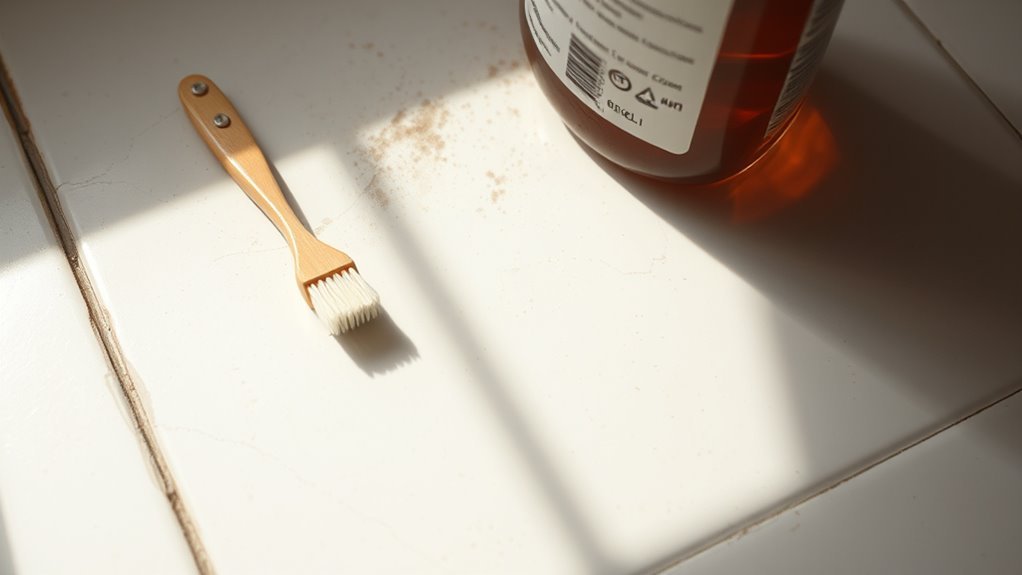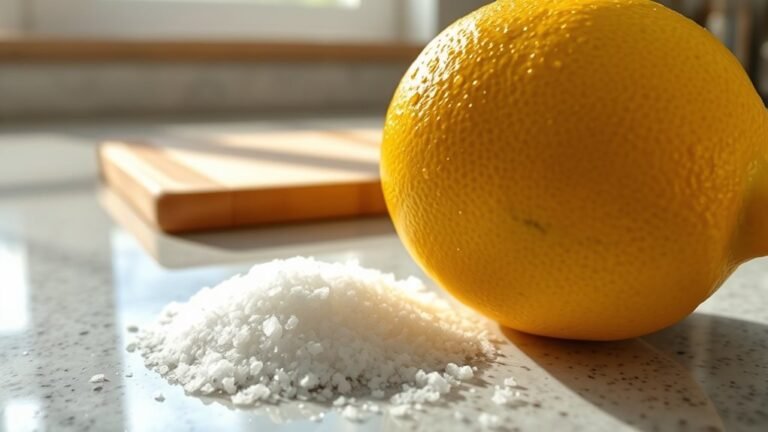Common Mistakes When Cleaning Grout
When cleaning grout, avoid harsh chemicals that erode its surface and cause discoloration. Don’t scrub too hard, as vigorous scrubbing weakens grout and creates stains. Skipping regular cleaning leads to buildup and damage over time, so keep a consistent routine. Applying sealant improperly or not at all leaves grout exposed to moisture and stains. Also, use proper tools—basic sponges won’t do. Understanding these common errors can help you protect and maintain your grout effectively.
Using Harsh Chemicals That Damage Grout
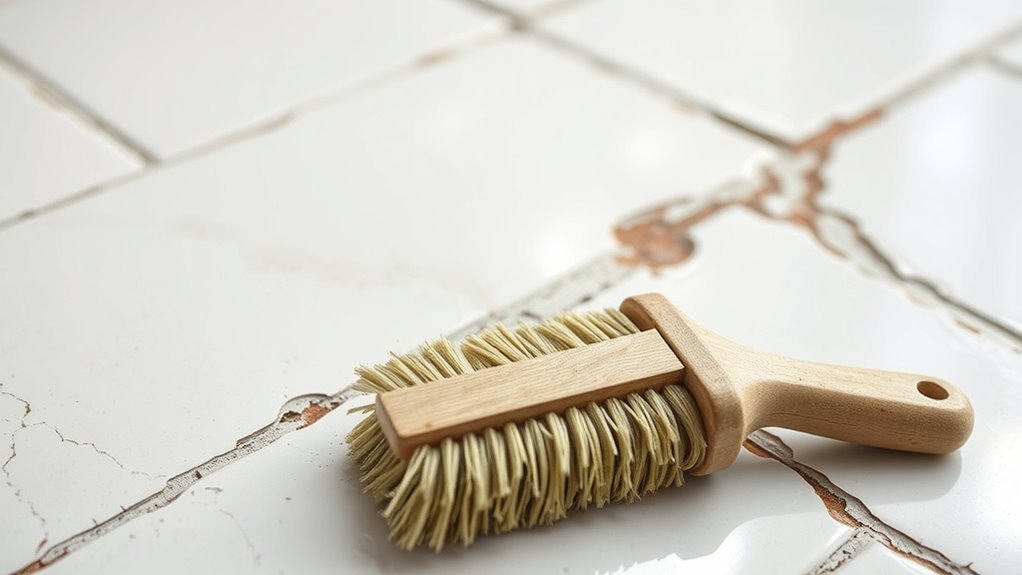
Although harsh chemicals might seem like a quick fix, using them can seriously damage your grout over time. When you rely on aggressive cleaners, you risk eroding the grout’s surface, leading to cracks and discoloration. Instead, consider chemical alternatives that provide effective cleaning without compromising grout integrity. These safer options often include natural enzymes or mild acids that break down dirt while preserving the grout’s structure. To maintain grout protection, apply sealants regularly; they create a barrier against stains and moisture, extending your grout’s lifespan. Embracing these gentler methods not only safeguards your grout but also gives you the freedom to clean confidently, knowing you’re preserving your surfaces rather than accelerating wear and tear. Choose smart, protective solutions over quick, harmful fixes.
Scrubbing Too Vigorously and Causing Wear
Choosing gentle cleaning solutions is only part of protecting your grout; how you clean it matters just as much. If you scrub too vigorously, you risk accelerating grout wear, which can lead to permanent damage and discoloration. Aggressive cleaning techniques may seem effective initially, but they erode the grout’s surface, weakening its structure and opening it to dirt and stains. Instead, adopt controlled motions using soft brushes or microfiber cloths. This approach preserves grout integrity while still removing grime effectively. Remember, your goal is to maintain both cleanliness and longevity. Avoid excessive force and harsh scrubbing tools, as they compromise your grout’s durability. By mastering gentle, consistent cleaning techniques, you guarantee your grout remains intact and visually appealing, granting you the freedom to enjoy a pristine space without unintended damage.
Ignoring Regular Cleaning and Maintenance
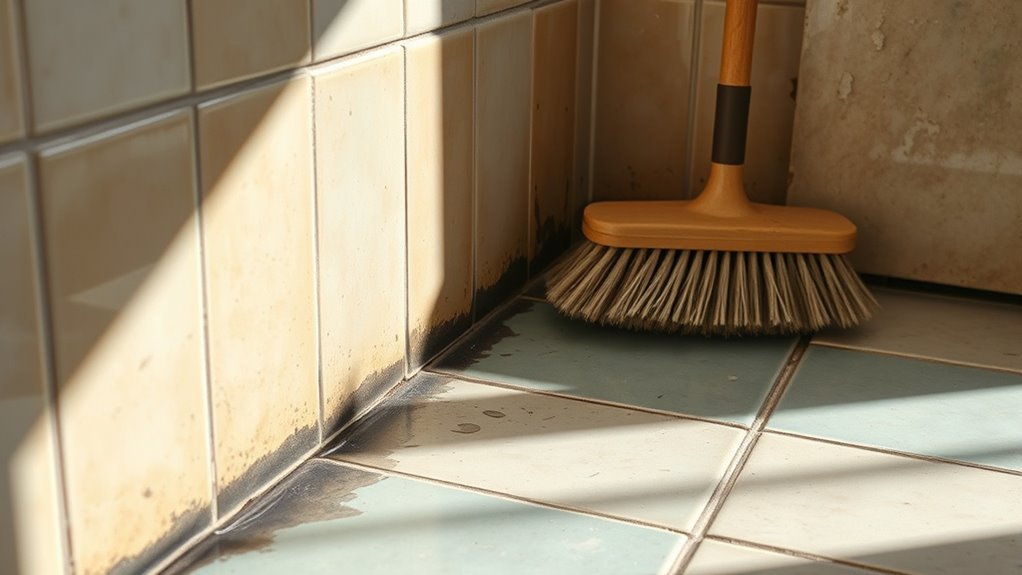
Neglecting regular cleaning and maintenance is one of the most common mistakes you can make with grout care. When you skip consistent upkeep, dirt and grime build up, leading to discoloration and weakening the grout’s structure. To guarantee grout longevity, it’s essential to establish a maintenance frequency that fits your lifestyle—typically, a quick clean every week and a deep clean monthly. This routine prevents stubborn stains and deterioration that can compromise your tile’s appearance and durability. Ignoring this simple step restricts your freedom to enjoy a clean, fresh space without costly repairs or replacements. By committing to regular maintenance, you take control over grout’s lifespan and maintain your home’s aesthetic without the hassle of extensive restoration down the line.
Applying Sealant Incorrectly or Not at All
If you don’t apply grout sealant properly—or skip it altogether—you’re leaving your grout vulnerable to stains, moisture, and damage. Sealant application is essential for grout protection, creating a barrier that repels water and dirt, preserving its integrity. When applying sealant, verify the grout is thoroughly clean and dry; any residue or moisture can prevent proper adhesion. Use a high-quality sealant designed for grout and follow the manufacturer’s instructions closely. Applying too much sealant or missing spots compromises effectiveness, so work methodically. Remember, sealant isn’t a one-time fix—you’ll need to reapply it periodically to maintain peak grout protection. Proper sealant application not only extends your grout’s lifespan but also grants you the freedom to clean confidently without worrying about permanent damage.
Overlooking the Importance of Proper Tools
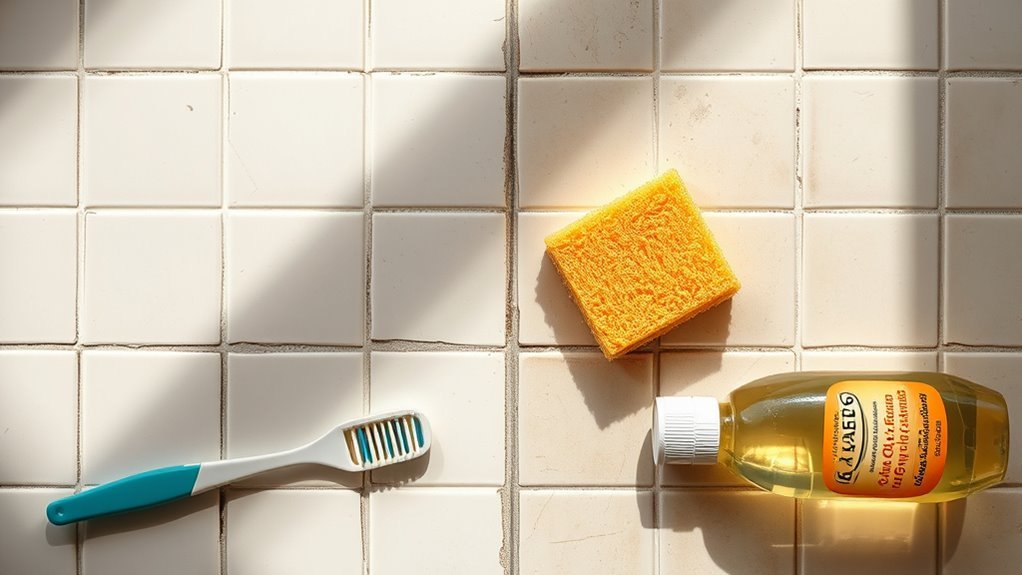
Proper tools are essential for effective grout cleaning, yet many people underestimate their impact. If you want to maintain freedom from constant re-cleaning, using the right equipment is non-negotiable. Basic household sponges won’t cut it; instead, invest in quality grout brushes designed to reach deep into crevices and remove stubborn dirt. For a more thorough and chemical-free approach, steam cleaners offer powerful steam penetration that loosens grime without damaging grout. Overlooking these tools often leads to incomplete cleaning and frustration. By equipping yourself with grout brushes and steam cleaners, you harness precision and efficiency, saving time and effort. Don’t compromise on tools—your grout’s appearance and longevity depend on it. Choosing proper tools sets you free from ineffective cleaning cycles.
Frequently Asked Questions
Can Vinegar Damage Grout Over Time?
You might be wondering if vinegar effects grout negatively over time. While vinegar’s acidity can break down grout’s protective sealant, leading to erosion and weakened grout longevity, occasional use in diluted form is generally safe. However, regular or concentrated vinegar cleaning can cause damage, reducing grout durability. To preserve grout longevity, it’s best to use pH-neutral cleaners or vinegar sparingly, ensuring your grout stays intact and your freedom to clean confidently remains.
How Often Should Grout Be Resealed?
Wondering how often you should reseal your grout? The grout maintenance frequency typically depends on its exposure to moisture and wear, but generally, every 1 to 3 years is ideal. Using proper resealing techniques guarantees a strong barrier against stains and damage, giving you freedom from frequent deep cleaning. Keep an eye on grout condition and reseal promptly to protect your surfaces and extend their lifespan effortlessly.
What Is the Best Natural Grout Cleaner?
If you’re looking for the best natural grout cleaner, try a paste made from baking soda and hydrogen peroxide. Baking soda acts as a gentle abrasive, while hydrogen peroxide breaks down stains and disinfects. Mix them into a thick paste, apply it to grout, let it sit for 5-10 minutes, then scrub with a brush. This combo offers a powerful, chemical-free way to restore grout without harsh toxins, giving you cleaning freedom.
Can Mold Grow in Grout Lines?
Yes, mold can grow in grout lines, especially in damp areas like bathrooms. To prevent mold, you’ll need consistent grout maintenance—keep the lines clean and dry. Regularly ventilate spaces and use mold prevention products if needed. By staying on top of grout care, you’ll avoid stubborn mold build-up and keep your space fresh, giving you the freedom to enjoy a healthy, clean environment without worrying about hidden mold issues.
Is Grout Cleaning Safe for Colored Grout?
You might worry grout cleaning could fade your colored grout, but with the right grout cleaning techniques, it’s perfectly safe. To keep your colored grout looking vibrant, use gentle, pH-neutral cleaners designed for colored grout maintenance. Avoid harsh chemicals or abrasive tools that can damage the pigment. By following proper methods, you’ll preserve your grout’s color while effectively removing dirt and mold, ensuring your space stays fresh and free.
